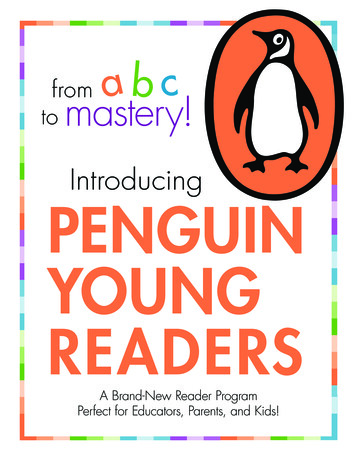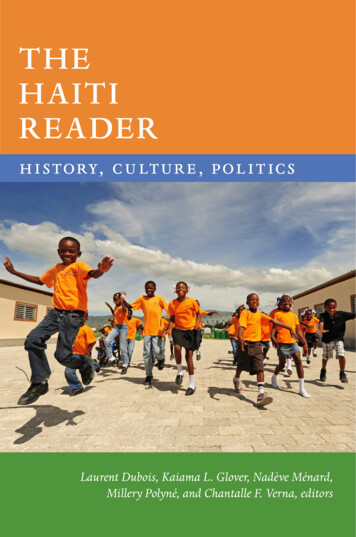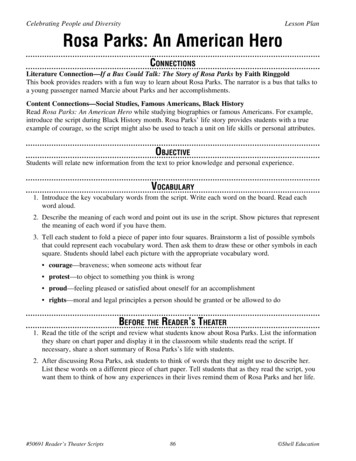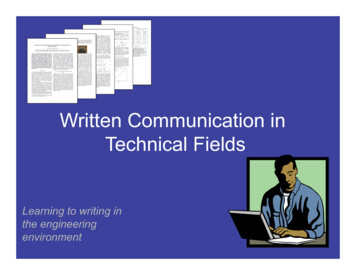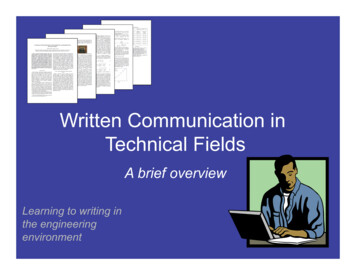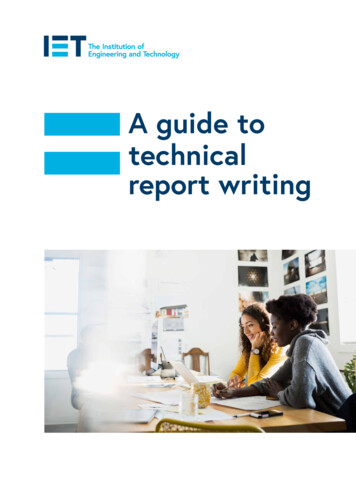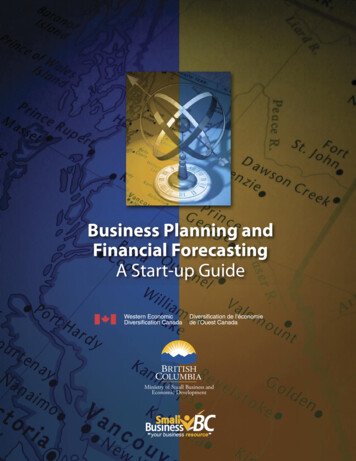
Transcription
0582894107 cvr22/2/052:21 PMPage 1.Fifth editionRAMAN SELDENPETER WIDDOWSONPETER BROOKERThe best of the many guides to literary theory that are currently available. Widdowsonand Brooker chart a clear and comprehensively documented path through the full rangeof what is best in contemporary literary theory.indispensable for all students of literature An impressive achievement!John Drakakis, Stirling UniversityThis Guide is as stimulating and instructive an introduction to [literary theory] as any readermight wish for.John Kenny, Centre for the Study of Human Settlement and Historical Change,National University of Ireland, GalwayA Reader’s Guide to Contemporary Literary Theory is a classic introduction to the ever-evolvingfield of modern literary theory, now expanded and updated in its fifth edition. This book presentsthe full range of positions and movements in contemporary literary theory. It organises thetheories into clearly defined sections and presents them in an accessible and lucid style.Students are introduced, through succinct but incisive expositions, to New Criticism, ReaderResponse Theory, Marxist Criticism, Structuralism, Post-Structuralism, Post-Modernism andFeminism, as well as to Cultural Materialism and New Historicism, Postcolonialism and Gay,Lesbian and Queer Theory.A Reader’s Guide to Contemporary Literary TheoryA Reader’s Guide to ContemporaryLiterary Theory Fifth editionThis new edition also considers the ‘New Aestheticism’ and engages with the idea of ‘Post-Theory’.This comprehensive book also contains extensively revised Further Reading lists, including weband electronic resources, and two appendices which recommend glossaries of key theoretical andcritical terms and relevant journals.Peter Widdowson is Professor of Literary Studies at the University of Gloucestershire. His mostrecent books include: Literature (1999); The Palgrave Guide to English Literature and its Contexts1500–2000 (2004) and Graham Swift (2005).Peter Brooker is Professor of Literary and Cultural Studies at the University of Nottingham. He isthe author most recently of Modernity and Metropolis. Literature, Film and Urban Formations(2002); Bohemia in London. The Social Scene of Early Modernism (2004); and A Glossary ofCultural Theory (second edition, 2002). He is co-editor of Geographies of Modernism (2005) andco-founder of ‘The Modernist Magazines Project’.Cover image: Norwich, 1999by Sir Howard Hodgkin Howard HodgkinDigital Image Tate, London 2005www.pearson-books.comSELDEN, WIDDOWSON, BROOKERRaman Selden is late Professor of English at the University of Sunderland.A Reader’s Guide to ContemporaryLiterary TheoryFifth editionRAMAN SELDENPETER WIDDOWSONPETER BROOKER
ARG A01.qxd 9/20/07 10:44 AM Page i.A Reader’s Guide toContemporary Literary Theory
ARG A01.qxd 9/20/07 10:44 AM Page ii.
ARG A01.qxd 9/20/07 10:44 AM Page iii.A Reader’s Guideto ContemporaryLiterary TheoryFIFTH EDITIONRaman SeldenPeter WiddowsonPeter Brooker
ARG A01.qxd 9/20/07 10:44 AM Page iv.PEARSON EDUCATION LIMITEDEdinburgh GateHarlow CM20 2JEUnited KingdomTel: 44 (0)1279 623623Fax: 44 (0)1279 431059Website: www.pearsoned.co.ukFifth edition published in Great Britain in 2005 Prentice Hall Europe 1985, 1997 Pearson Education Limited 2005The rights of Raman Selden, Peter Widdowson andPeter Brooker to be identified as authorsof this work has been asserted in accordancewith the Copyright, Designs and Patents Act 1988.ISBN: 978-0-582-89410-5British Library Cataloguing in Publication DataA CIP catalogue record for this book can be obtained from the British LibraryLibrary of Congress Cataloging in Publication DataSelden, Raman.A reader’s guide to contemporary literary theory / Raman Selden, Peter Widdowson,Peter Brooker.— 5th ed.p. cm.Includes bibliographical references and index.ISBN 0-582-89410-7 (pbk.)1. Criticism—History—20th century. I. Widdowson, Peter. II. Brooker, Peter. III. Title.PN94.S45 2005801'.95'0904—dc222004063377All rights reserved; no part of this publication may be reproduced, storedin a retrieval system, or transmitted in any form or by any means, electronic,mechanical, photocopying, recording, or otherwise without either the priorwritten permission of the Publishers or a licence permitting restricted copyingin the United Kingdom issued by the Copyright Licensing Agency Ltd,Saffron House, 6-10 Kirby Street, London EC1N 8TS. This book may not be lent,resold, hired out or otherwise disposed of by way of trade in any formof binding or cover other than that in which it is published, without theprior consent of the Publishers.10 9 8 709 08 07654Set in 9/13.5pt Stone Serif by 35Printed and bound in Malaysia, PJBThe Publishers’ policy is to use paper manufactured from sustainable forests.
ARG A01.qxd 9/20/07 10:44 AM Page v.In memory of Raman Selden, as always.
ARG A01.qxd 9/20/07 10:44 AM Page vi.
ARG A01.qxd 9/20/07 10:44 AM Page vii.Contents1Preface to the Fifth EditionIntroductionix1New Criticism, moral formalism and F. R. Leavis15Origins: Eliot, Richards, Empson 15The American New Critics 18Moral formalism: F. R. Leavis 232Russian formalism and the Bakhtin School29Shklovsky, Mukařovský, Jakobson 30The Bakhtin School 393Reader-oriented theories45Phenomenology: Husserl, Heidegger, Gadamer 49Hans Robert Jauss and Wolfgang Iser 50Fish, Riffaterre, Bleich 554Structuralist theories62The linguistic background 63Structuralist narratology 67Metaphor and metonymy 72Structuralist poetics 755Marxist theoriesSoviet Socialist Realism 84Lukács and Brecht 86The Frankfurt School and After: Adorno and Benjamin 91‘Structuralist’ Marxism: Goldmann, Althusser, Macherey 95‘New Left’ Marxism: Williams, Eagleton, Jameson 9982
ARG A01.qxd 9/20/07 10:44 AM Page viii.viiiCONTENTS6Feminist theories115First-wave feminist criticism: Woolf and de Beauvoir 117Second-wave feminist criticism 120Kate Millett: sexual politics 123Marxist feminism 125Elaine Showalter: gynocriticism 126French feminism: Kristeva, Cixous, Irigaray 1297Poststructuralist theories144Roland Barthes 148Psychoanalytic theories: 153Jacques Lacan 156Julia Kristeva 161Deleuze and Guattari 162Deconstruction: Jacques Derrida 164American deconstruction 171Michel Foucault 178New Historicism and Cultural Materialism 1808Postmodernist theories197Jean Baudrillard 200Jean-François Lyotard 203Postmodernism and Marxism 206Postmodern feminisms 2099Postcolonialist theories218Edward Said 220Gayatri Chakravorty Spivak 223Homi K. Bhabha 226Race and ethnicity 22910Gay, lesbian and queer theories243Gay theory and criticism 244Lesbian feminist theory and criticism 247Queer theory and criticism 252Conclusion: Post-TheoryAppendix 1: Recommended glossaries of theoreticaland critical terms and conceptsAppendix 2: Literary, critical and cultural theory journalsIndex of names, titles and topics267280282283
ARG A01.qxd 9/20/07 10:44 AM Page ix.Preface to the Fifth EditionRaman Selden’s original A Reader’s Guide to ContemporaryLiterary Theory (1985) now appears in a new fifth edition. Somelittle while after revising the second edition in 1989, Raman prematurelyand tragically died of a brain tumour. He was much loved and highlyrespected – not least for the remarkable achievement of producing a short,clear, informative and unpolemical volume on a diverse and difficultsubject. A third edition appeared in 1993, brought up-to-date by PeterWiddowson, and in 1997 he was joined by Peter Brooker in an extensivereworking of the fourth edition (debts to other advisers who assisted themon those occasions are acknowledged in previous Prefaces). Now, in 2005,and as witness to its continuing success and popularity, the moment forfurther revision of A Reader’s Guide has arrived once more.Twenty years is a long time in contemporary literary theory, and theterrain, not surprisingly, has undergone substantial change since RamanSelden first traversed it. As early as the third edition, it was noted that, inthe nature of things, the volume was beginning to have two rather moreclearly identifiable functions than it had when the project was initiated.The earlier chapters were taking on a historical cast in outlining movementsfrom which newer developments had received their impetus but had thensuperseded, while the later ones attempted to take stock of precisely thosenewer developments, to mark out the coordinates of where we live andpractise theory and criticism now. This tendency was strengthened in thereordering and restructuring of the fourth edition, and the present versioncontinues to reflect it, so that the last five chapters – including a new concluding one on what it might mean to be ‘Post-Theory’ – now comprisehalf the book. The Introduction reflects, amongst other things, on the issueswhich lie behind the current revisions, and the reading lists have, ofcourse, again been extensively updated.
ARG A01.qxd 9/20/07 10:44 AM Page x.
ARG A01.qxd 9/20/07 10:44 AM Page xi.CONTENTSXI
ARG A02.qxd 07/02/2005 14:26 Page 1.IntroductionIt is now twenty years since Raman Selden undertook thedaunting task of writing a brief introductory guide to contemporary literary theory, and it is salutary to consider how much has changedsince the initial publication of A Reader’s Guide in 1985. In his Introductionto that first edition, it was still possible for Raman to note that,until recently ordinary readers of literature and even professional literary criticshad no reason to trouble themselves about developments in literary theory.Theory seemed a rather rarefied specialism which concerned a few individualsin literature departments who were, in effect, philosophers pretending to beliterary critics. . . . Most critics assumed, like Dr Johnson, that great literaturewas universal and expressed general truths about human life . . . [and] talkedcomfortable good sense about the writer’s personal experience, the social andhistorical background of the work, the human interest, imaginative ‘genius’and poetic beauty of great literature.For good or ill, no such generalizations about the field of literary criticismcould be made now. Equally, in 1985 Raman would rightly point to theend of the 1960s as the moment at which things began to change, and comment that ‘during the past twenty years or so students of literature havebeen troubled by a seemingly endless series of challenges to the consensusof common sense, many of them deriving from European (and especiallyFrench and Russian) intellectual sources. To the Anglo-Saxon tradition, thiswas a particularly nasty shock.’ But he could also still present ‘Structuralism’ as a newly shocking ‘intruder in the bed of Dr Leavis’s alma mater’(Cambridge), especially a structuralism with ‘a touch of Marxism about [it]’,and note the even more outré fact that there was already ‘a poststructuralistcritique of structuralism’, one of the main influences on which was the
ARG A02.qxd 07/02/2005 14:26 Page 2.2A READER’S GUIDE TO CONTEMPORARY LITERARY THEORY‘psychoanalytic structuralism’ of the French writer, Jacques Lacan. All ofwhich, he could say at the time, ‘only confirmed ingrained prejudices’. Nocriticism of Raman, of course – indeed, that he could say this is to makethe very point – but such a conjuncture within ‘English’ or Literary Studiesnow seems to belong irrevocably to the dim and distant past. As later pagesof the present introduction attest, over the last twenty years a seismic changehas taken place which has transformed the contours of ‘contemporaryliterary theory’, and which has therefore required a reconfiguration ofA Reader’s Guide to match.Nevertheless, we retain – along with, it is only fair to note, a good proportion of what Raman originally wrote in the first editions of the book –a commitment to many of his founding beliefs about the need for aconcise, clear, introductory guide to the field. We might add that theconstant fissurings and reformations of contemporary theory since seem toreconfirm the continuing need for some basic mapping of this complex anddifficult terrain, and the Guide’s widespread adoption on degree coursesthroughout the English-speaking world also appears to bear this out.It goes without saying, of course, that ‘theory’ in the fullest generic senseis not a unique product of the late twentieth century – as its Greek etymology, if nothing else, clearly indicates. Nor, of course, is Literary or CriticalTheory anything new, as those will confirm who studied Plato, Aristotle,Longinus, Sidney, Dryden, Boileau, Pope, Burke, Coleridge and Arnold intheir (traditional) ‘Literary Theory’ courses. Indeed, one of Raman Selden’sother (edited) books is entitled The Theory of Criticism from Plato to the Present:A Reader (1988). Every age has its theoretical definitions of the nature ofliterature and its theorized principles on which critical approaches to theanalysis of literature are premised. But in the 1980s, Fredric Jameson madea telling observation in his essay, ‘Postmodernism and Consumer Society’(in Kaplan (ed.), 1988: see ‘Further reading’ for Chapter 8); he wrote: ‘Ageneration ago, there was still a technical discourse of professional philosophy . . . alongside which one could still distinguish that quite different discourse of the other academic disciplines – of political science, for example,or sociology or literary criticism. Today, increasingly, we have a kind of writing simply called “theory” which is all or none of these things at once.’This ‘theoretical discourse’, he goes on, has marked ‘the end of philosophyas such’ and is ‘to be numbered among the manifestations of postmodernism’.The kinds of originary theoretical texts Jameson had in mind were thosefrom the 1960s and 1970s by, for example, Barthes, Derrida, Foucault, Lacan,Althusser, Kristeva, together with earlier ‘remobilized’ texts by, among others,Bakhtin, Saussure, Benjamin and the Russian Formalists. Through the
ARG A02.qxd 07/02/2005 14:26 Page 3.INTRODUCTION1980s and 1990s, this process seemed to compound itself in self-generatingfashion, with ‘Theory’ (now adorned by a tell-tale capital ‘T’) being put onthe syllabus by a plethora of Readers, Guides and introductory handbooks.Certainly in ‘English’ – plunged into a permanent state of ‘crisis’ (but only,it appeared, for those who did not want to countenance change) – ‘Theory’courses became de rigueur, prompting one of the central and unresolveddebates in that discipline at least: ‘How to Teach Theory’ (more on this later).This period (c.late 1960s to late 1990s), we may call ‘Theorsday’ – or, morerecognizably, ‘The Moment of Theory’ – a historically and culturally specific phenomenon coterminous with Poststructuralism, Postmodernism andthe sidelining of materialist politics, a period which, it now seems, has beensuperseded by one declared ‘post-Theory’ (see below and the Conclusion tothe present volume).But back in 1985, Raman Selden’s impetus in writing A Reader’s Guidewas because he believed that the questions raised by contemporary literarytheory were important enough to justify the effort of clarification, and becausemany readers by then felt that the conventional contemptuous dismissalof theory would no longer do. If nothing else, they wanted to know exactlywhat they were being asked to reject. Like Raman, we too assume that thereader is interested by and curious about this subject, and that s/he requiresa sketch-map of it as a preliminary guide to traversing the difficult groundof the theories themselves. Apropos of this, we also firmly hold that the‘Selected Reading’ sections at the end of each chapter, with their lists of‘Basic Texts’ and ‘Further Reading’, are an integral part of our project tofamiliarize the reader with the thinking which has constructed their present field of study: the Guide, in the beginning and in the end, is no substitute for the original theories.Inevitably, any attempt to put together a brief summation of complex and contentious concepts, to say much in little, will result in oversimplifications, compressions, generalizations and omissions. For example,we made the decision when revising the fourth edition that approachespremised on pervasive linguistic and psychoanalytic theories were best dispersed throughout the various chapters rather than having discrete sectionsdevoted to them. ‘Myth criticism’, which has a long and varied history andincludes the work of Gilbert Murray, James Frazer, Carl Jung, Maud Bodkinand Northrop Frye, was omitted because it seemed to us that it had notentered the mainstream of academic or popular culture, and had notchallenged received ideas as vigorously as the theories we do examine. Thechapter on New Criticism and F. R. Leavis comes before the one on RussianFormalism when even a cursory glance will indicate that chronologically3
ARG A02.qxd 07/02/2005 14:26 Page 4.4A READER’S GUIDE TO CONTEMPORARY LITERARY THEORYthe latter precedes the former. This is because Russian Formalism, albeit mainlyproduced in the second two decades of the twentieth century, did not havewidespread impact until the late 1960s and the 1970s, when it was effectively rediscovered, translated and given currency by Western intellectualswho were themselves part of the newer Marxist and structuralist movementsof that period. In this respect, the Russian Formalists ‘belong’ to that latermoment of their reproduction and were mobilized by the new left critics intheir assault, precisely, on established literary criticism represented most centrally, in the Anglo-Saxon cultures, by New Criticism and Leavisism. Hence,we present the latter as anterior to Formalism in terms of critical theoretical ideology, because they represent the traditions of criticism, from theoutset and principally, with which contemporary critical theory had toengage. In any event, while the Reader’s Guide does not pretend to give acomprehensive picture of its field, and cannot be anything other than selective and partial (in both senses), what it does offer is a succinct overview ofthe most challenging and prominent trends within the theoretical debatesof the last forty years.But more generally, and leaving aside for the moment the fact that in2005, if not in 1985, the effects of these theoretical debates have so markedliterary studies that it is unthinkable to ignore them, why should wetrouble ourselves about theory? How, after all, does it affect our experienceand understanding of reading literary texts? One answer would be that somefamiliarity with theory tends to undermine reading as an innocent activity.If we begin to ask ourselves questions about the construction of meaningin fiction, the presence of ideology in poetry, or how we measure thevalue of a literary work, we can no longer naïvely accept the ‘realism’ of anovel, the ‘sincerity’ of a poem, or the ‘greatness’ of either. Some readersmay cherish their illusions and mourn the loss of innocence, but if theyare serious, they must confront the problematical issues raised about‘Literature’ and its social relations by major theorists in recent years. Otherreaders again may believe that theories and concepts will only deaden thespontaneity of their response to literary works, but they will thereby failto realize that no discourse about literature is theory-free, that even apparently ‘spontaneous’ discussion of literary texts is dependent on the de facto(if less self-conscious) theorizing of older generations. Their talk of ‘feeling’,‘imagination’, ‘genius’, ‘sincerity’ and ‘reality’ is full of dead theory whichis sanctified by time and has become part of the naturalized language ofcommon sense. A second answer might be, then, that far from having asterile effect on our reading, new ways of seeing literature can revitalize ourengagement with texts; that if we are to be adventurous and exploratory
ARG A02.qxd 07/02/2005 14:26 Page 5.INTRODUCTIONin our reading of literature, we must also be adventurous in our thinkingabout literature.One simple way of demonstrating the effect of theorizing literature isto see how different theories raise different questions about it from different foci of interest. The following diagram of linguistic communication,devised by Roman Jakobson, helps to distinguish some possible starting-points:CONTEXTADDRESSER MESSAGECONTACTCODE ADDRESSEEAn addresser sends a message to an addressee; the message uses a code(usually a language familiar to both addresser and addressee); the messagehas a context (or ‘referent’) and is transmitted through a contact (a mediumsuch as live speech, the telephone or writing). For the purposes of discussingliterature, the ‘contact’ is usually now the printed word (except, say, in dramaor performance-poetry); and so we may restate the diagram thus:CONTEXTWRITER WRITINGCODE READERIf we adopt the addresser’s viewpoint, we draw attention to the writer, andhis or her ‘emotive’ or ‘expressive’ use of language; if we focus on the ‘context’, we isolate the ‘referential’ use of language and invoke its historicaldimension at the point of the work’s production; if we are principally interested in the addressee, we study the reader’s reception of the ‘message’, henceintroducing a different historical context (no longer the moment of a text’sproduction but of its reproduction), and so on. Different literary theories alsotend to place the emphasis upon one function rather than another; so wemight represent some major earlier ones diagrammatically thus:ROMANTIC HUMANISTMARXISTFORMALISTSTRUCTURALIST READERORIENTEDRomantic-humanist theories emphasize the writer’s life and mind asexpressed in his or her work; ‘reader’ theories (phenomenological criticism)centre themselves on the reader’s, or ‘affective’, experience; formalist theories concentrate on the nature of the writing itself; Marxist criticism regardsthe social and historical context as fundamental; and structuralist poeticsdraws attention to the codes we use to construct meaning. At their best, of5
ARG A02.qxd 07/02/2005 14:26 Page 6.6A READER’S GUIDE TO CONTEMPORARY LITERARY THEORYcourse, none of these approaches totally ignores the other dimensions ofliterary communication: for example, Western Marxist criticism does nothold a strictly referential view of language, and the writer, the audienceand the text are all included within the overall sociological perspective.However, it is noteworthy in what we have outlined above that noneof the examples is taken from the more contemporary theoretical fields offeminism, poststructuralism, postmodernism, postcolonialism and gay, lesbian or queer theory. This is because all of these, in their different ways,disturb and disrupt the relations between the terms in the original diagram,and it is these movements which account for the disproportionate scale ofthe twenty-year gap between the moment when Raman Selden began thebook and the moment of its revision now.Developments in critical theory and practice have diversified in geometricprogression since 1985, and the shape and composition of the present version of A Reader’s Guide attempt to take account of this and are witness toit. Although not overtly structured to indicate such a change, the book isnow in two distinct halves. Those theories which comprised the entirety ofthe earlier editions have been reduced and pressed back into Chapters 1–6,or just about half of the whole volume. It is clear that these are now partof the history of contemporary literary theory, but are not accuratelydescribed as ‘contemporary literary theory’ themselves. This is not to saythat they are now redundant, sterile or irrelevant – their premises, methodologies and perceptions remain enlightening, and may yet be the sourceof still more innovative departures in theorizing literature – but in so faras they were the pace-makers for the new leaders of the field, they havedropped back and are out of the current race. A difficult decision in thiscontext was how to deal with the chapter on feminist theories. In earliereditions, this had concluded the book – signalling that this was wherethe action was; but the chronology of the chapter, often paralleling othertheories of the 1960s and 1970s, came to make it look like a gesturalafterthought: ‘and then there is feminism’. In the fourth edition, therefore, we returned the chapter comprising that time-frame, with its largely‘white’ Anglo-American and French focus, to its more appropriate placeat the end of the ‘historical’ half of the book, and dispersed accounts ofthe newer feminisms, taking account especially of their pivotal nonEurocentric energies, throughout the later ‘contemporary’ chapters. The longchapter on poststructuralism now contains rather more on psychoanalytictheories and an updating of the treatment of New Historicism and CulturalMaterialism. A previous single chapter on postmodernism and postcolonialism was split in the fourth edition into two separate chapters, with new
ARG A02.qxd 07/02/2005 14:26 Page 7.INTRODUCTIONsections which introduced both theorists who had only more recentlybegun to make a major mark on the field and the impact of work aroundgender, sexuality, race and ethnicity. In addition, there was an entirelynew chapter on gay, lesbian and queer theories, which brought the book’scoverage of the most dynamic areas of activity up-to-date. Most of the abovehas been retained in the present fifth edition, although revised and refinedwhere necessary. The most significant addition here, however, is the concluding chapter on ‘Post-Theory’, which takes stock of the various emergent tendencies and debates regarding aesthetics and politics which areoccurring under its banner. Finally, the ‘Selected Reading’ sections haveagain been recast to make them more accessible and up-to-date. Onenotable change in these is the inclusion (in square brackets) of dates offirst publication for many of the founding texts of contemporary literarytheory in order to indicate how much earlier they often are than themodern editions by which they subsequently made their impact. Equally,the date of translation into English of seminal European texts is includedfor the same reason.So what has been the turbulence between 1985 and 2005 in the field of‘contemporary literary theory’; what is the context which explains the continuous need to revise A Reader’s Guide? For a start, ‘Theory’, even ‘literarytheory’, can no longer usefully be regarded as a progressively emerging bodyof work, evolving through a series of definable phases or ‘movements’ – ofdelivery, critique, advancement, reformulation, and so on. This appearedto be the case in the later 1970s and early 1980s – although no doubt itwas never entirely true – when the ‘Moment of Theory’ seemed to havearrived and there was an anxiety, even to those enthusiastically participating in it, that a new academic subject, worse a new scholasticism – radicaland subversive, yes, but also potentially exclusive in its abstraction – wascoming into being. Books poured from the presses, conferences abounded,‘Theory’ courses at undergraduate and postgraduate level proliferated, andany residual notions of ‘practice’ and of ‘the empirical’ became fearsomelyproblematical. Such a ‘Moment of Theory’ no longer obtains – whether, paradoxically, because it coincided with the rise to political power of the newright, whether because, by definition in a postmodern world, it could notsurvive in a more or less unitary state, or whether it contained, as itself apostmodern creature, the catalysing agents for its own dispersal, are beyondconfident assertion. But a change has occurred – a change producing a situation very different to that of the increasingly abstract and self-obsessedintellectual field which the original edition of this book felt itself just aboutable to describe and contain. First, the singular and capitalized ‘Theory’ has7
ARG A02.qxd 07/02/2005 14:26 Page 8.8A READER’S GUIDE TO CONTEMPORARY LITERARY THEORYdevolved rapidly into ‘theories’ – often overlapping and mutually generative, but also in productive contestation. The ‘Moment of Theory’, in otherwords, has spawned a hugely diverse tribe of praxes, or theorized practices,at once self-conscious about their projects and representing radical formsof political action, at least in the cultural domain. This has been particularly the case with critical theories and practices which focus on genderand sexuality and with those which seek to deconstruct Euro- and ethnocentricity. Second, given the postmodern theoretical fission we have suggested above, there has been a turn in some quarters to ostensibly moretraditional positions and priorities. The verdict here is that ‘Theory Has Failed’:that, in an ironic postmodern twist, the ‘End of Theory’ is now with us.This is by no means the Lazarus-like spasms of the old guard come backfrom the dead, but the view of younger academics who have gone throughthe theory mill and who wish to challenge the dominance of theoreticaldiscourse in literary studies on behalf of literature itself – to find a way oftalking about literary texts, about the experience of reading and evaluatingthem. As the concluding chapter in the present edition makes clear, thisaspect of ‘post-theory’ is most perceptible in the tendency towards a so-called‘New Aesthetics’. The question of ‘practice’ in the present theoretical context we will return to briefly below.Other related effects of developments in contemporary theory over thepast decades may be adduced as follows. Perhaps the most notable has beenthe deconstruction of notions of a given literary canon – of an agreed selection of ‘great works’ which are the benchmark for the discrimination of‘literary value’, and without exposure to which no literary education canbe complete. The theoretical challenging of the criteria on which thecanon is established, together with the arrival on the agenda of many moremarginal kinds of literary and other cultural production hitherto excludedfrom it, has at once ca
recent books include: Literature (1999); The Palgrave Guide to English Literature and its Contexts 1500–2000 (2004) and Graham Swift(2005). Peter Brookeris Professor of Literary and Cultural Studies at the University of Nottingham. He is the author most recently of Modernity and Metropolis.

